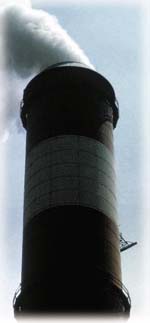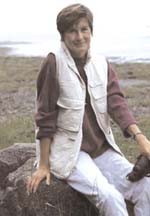
![]()
Volume 6, No. 2
Promoting Cooperation to Maintain and Enhance
Environmental Quality in the Gulf of Maine
|
||||||||||
|
Regular columns |
|
Archives |
|
About |
Top Stories
A good thing gone awry:
The environmental disruption caused by an overload of nitrogen is emerging as a new concern for the Gulf of Maine
By Andi Rierden, Editor
 Nitric oxides from smokestacks and other sources are a main contributor of excess nitrogen in the Gulf of Maine region. Source: National Renewable Energy Laboratory |
As a fertilizer for lawns, gardens or farm fields, nitrogen has long been thought of as mostly benign and beneficial. The element occurs naturally and is essential to plant growth, and thus to animal growth. A common chemical in living tissues, nitrogen is a component of amino acids, the building blocks of protein. As a manufactured fertilizer, the compound has made modern-day agriculture possible. It is so useful, in fact, that human beings have more than doubled the amount of nitrogen naturally available to the Earth's ecosystems over the past century.
And therein lies the rub. Behind nitrogen's amazing ability to stimulate growth dwells the reason for the havoc it can cause. Among the disturbing findings, science has established that an excess of chemically "fixed" nitrogen is harming and altering ecosystems by making plants poorly equipped to cope with nitrogen-rich environments disappear.
World-wide, the major sources of excess nitrogen are many and varied, including industrial processes that produce nitrogen fertilizers, the burning of fossil fuels in automobiles and power plants, and the clearing of forests and draining of wetlands, which free nitrogen from long-term storage in soil and tree trunks. Run-off from farm fields, wastewater treatment plants, faulty septic systems and fish wastes from aquaculture operations also add to the nitrogen glut.
In marine and coastal systems, nitrogen is the main ingredient that kick-starts a sequence of ecological impacts called eutrophication. The condition occurs when a surfeit of nitrogen promotes an extensive growth of phytoplankton and seaweed, or macroalgae. While they live, these organisms can cloud the water, blocking sunlight to By Lee Bumsted
Dr. Shaw, an environmental toxicologist and public health professional, founded MERI 12 years ago to conduct research and provide education on the impacts of pollution on marine life and human health. "Marine mammals like seals are important in their own right and also as significant sentinels for ocean health and the effects of pollutants in humans," Shaw says. Since they are at the top of the food chain, seals and other marine mammals are vulnerable to accumulating dangerous levels of persistent organic pollutants such as PCB's, DDT and dioxins by feeding on contaminated fish. Humans who eat fish share some of the seals' dietary preferences and potentially face similar health threats.
Persistent organic pollutants, along with metals such as lead and mercury, make up a group of contaminants called endocrine disruptors. These
more...
By Maureen Kelly
A U.S. Geological Survey (USGS) research site on Cape Cod will close in September if Congress approves the proposed cut of the agency's $13.9 million Toxics Substances Hydrology Program from the federal budget in fiscal year 2003.
Since 1983, the USGS has studied an underground sewage plume emanating from the 22,000-acre Massachusetts Military Reservation (MMR) in an effort to understand the processes that affect the behavior of contaminants in groundwater. Sewage is the most common threat to ground water purity in the United States. What scientists learn from the Cape Cod site can be applied to remediation at other contaminated aquifers nationwide.
In the late 1970s, the USGS discovered what is now called the Ashumet Valley Plume; the first of 15 contaminant plumes found originating beneath the base. Over nearly a century,
Seals as the Gulf of Maine's sentinels
 Susan Shaw, the energetic executive director of the Marine Environmental Research Institute (MERI) in Blue Hill, Maine, believes that seals in the Gulf of Maine can alert us to threats to human health. "Just as the songbirds in Rachel Carson's Silent Spring warned of the approaching dangers of DDT pollution, so can observations of our local seal population inform us of imminent threats," she says. "Wildlife signal us about toxic chemicals in our shared environment, and we need to read the signals correctly."
Susan Shaw, the energetic executive director of the Marine Environmental Research Institute (MERI) in Blue Hill, Maine, believes that seals in the Gulf of Maine can alert us to threats to human health. "Just as the songbirds in Rachel Carson's Silent Spring warned of the approaching dangers of DDT pollution, so can observations of our local seal population inform us of imminent threats," she says. "Wildlife signal us about toxic chemicals in our shared environment, and we need to read the signals correctly."
Cape Cod toxics program slated to be cut